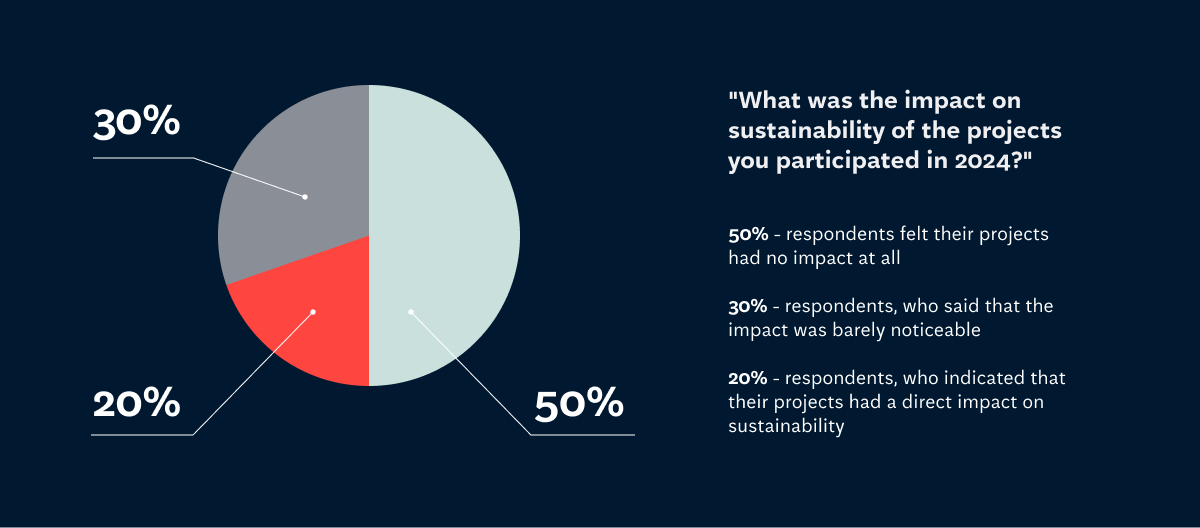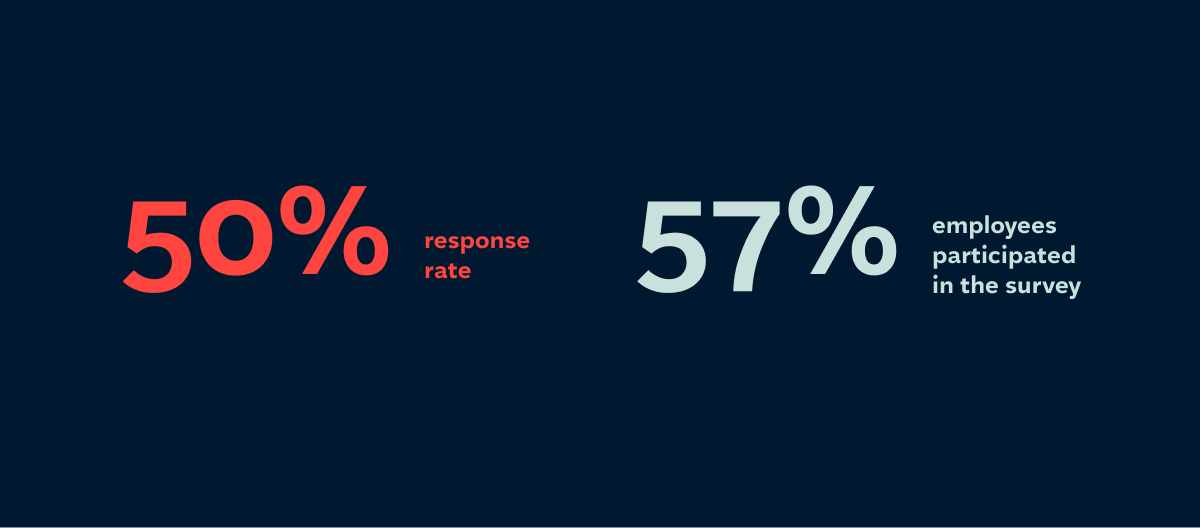How to implement sustainable IT projects? Employee insights and proven strategies
November 8, 2024 / 3 min read

Table of contents
Sustainability is now a key focus for tech companies. In a recent survey at our company, we learned more about how our employees view sustainability and how they approach it. These insights are helping us apply sustainable practices more effectively in our IT projects.
The survey results give us a strong base to improve our sustainability efforts. With 57 employees participating, we had a 50% response rate, showing that our team is highly engaged with this important topic.
Sustainability as a Priority
The survey results reveal that we need a clearer definition and vision of how sustainability should be integrated into our projects. While many see its value, it’s not yet a top priority in day-to-day work. Our employees highlighted the need for more knowledge of ESG (Environmental, Social, and Corporate Governance) and better sharing of this knowledge across the company to better guide clients and apply these principles in practice. Some also pointed out that we lack clear definitions of sustainability in the context of our projects. To address this, we need to set clearer evaluation criteria, expand sustainability education, and raise awareness of its importance.
We need to take concrete steps to make sustainability a core part of our operations. To do this effectively, we should focus on key areas that impact the environment, society, and business in our daily work.
Optimizing Energy Usage
Minimizing electricity consumption in IT projects is one of the key aspects of sustainability. In practice, this can be achieved by:
- Using energy-efficient servers and data centres powered by renewable energy sources (e.g., Google Cloud, AWS),
- Optimising code to make applications run more efficiently and use fewer resources,
- Compressing media and implementing technologies like lazy loading, which reduce network traffic and the amount of data processed by servers,
- Saving energy in user interfaces, for example, by reducing the number of animations or using dark themes on OLED screens.
Social Responsibility in IT Projects
IT projects must also consider the social aspects of sustainability. Delivered products should be accessible to all users, including people with disabilities. This requires compliance with WCAG standards and:
- Adding alternative text for images and transcriptions for videos,
- Ensuring keyboard navigation and compatibility with various devices. Additionally, an ethical approach to managing user data, protecting privacy, and ensuring security are key aspects of social responsibility.
Use of Recyclable Tools and Resources
In the area of sustainability, proper management of IT equipment is also important. Practices such as:
- Giving devices a second life, e.g., by repairing or replacing HDDs with SSDs, speeding up the computer while reducing energy consumption,
- Choosing hardware and components that are recyclable, can significantly reduce a company’s carbon footprint.
Ethics and Social Justice in Projects
Every IT project should take into account the principles of social justice and ethical treatment of employees. This means upholding human rights, avoiding discrimination, and promoting equal opportunities. Only this way can we build a healthy and ethical work environment.
Technologies for Energy Efficiency
Technology can also support sustainability by improving air quality and reducing greenhouse gas emissions. Actions such as:
- Promoting remote or hybrid work, which reduces vehicle emissions,
- Limiting business travel and replacing it with online meetings, are simple but effective ways to reduce a company’s environmental impact.
Economic Efficiency in Projects
Sustainability is not just about ecology but also about economic efficiency. Creating solutions that are durable, easy to maintain, and scalable can benefit both the environment and the company. It’s worth considering:
- Open-source software, which is developed by a large community and often cheaper to maintain,
- Modular software architectures that facilitate future updates without requiring major system changes.
Team Education and Awareness
As project leaders, we must continuously raise our team's awareness of sustainability. Organizing workshops, training sessions, and regularly gathering feedback from users and stakeholders to help iteratively improve our products toward greater sustainability.
It's worth noting that 21% of respondents indicated that their projects had a direct impact on sustainability in 2024, while 30% believed the impact was barely noticeable, and 50% felt their projects had no impact at all. This shows there is significant room for improvement in promoting and executing sustainable initiatives within the company.
Undoubtedly, sustainability in IT is a challenge that requires commitment at both the project and the company’s strategic levels. By introducing the right practices, we can minimise the negative impact of technology on the environment while achieving business goals. The survey conducted in our company clearly shows that we are on the right path, but further actions are needed to make sustainability an integral part of all our projects.
Author

Magdalena Muszyńska-Kęsek
HR, Payroll and Finance Business Partner
Magda, our head of people and Culture, leads NoA Ignite’s HR initiatives, which promote an inclusive and supportive environment for everyone.
Related articles
![A well-crafted prompt doesn’t just work once. It works across teams, channels, and campaigns. It can be tweaked for new use cases and refined based on what performs best.]()
June 27, 2025 / 4 min read
Prompts are marketing assets: how to reuse, and scale them
Prompts aren’t throwaway lines. They’re repeatable, scalable assets that can streamline your marketing your team’s output. Learn how to build a prompt library that delivers.
![Woman using a wheelchair in the office settings]()
June 17, 2025 / 5 min read
What is accessibility and why it matters?
Accessibility ensures everyone — including those with disabilities or limitations — can read, navigate, and engage with your content equally.





